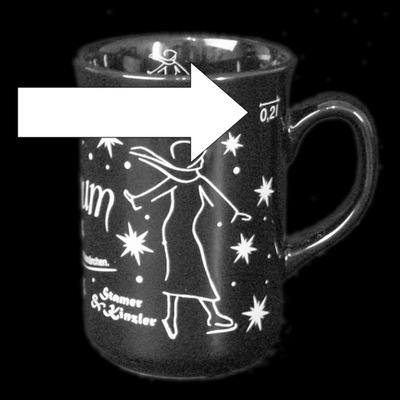Calibrations

Legal theory: Labelling the contents of porcelain cups, mugs and other hollowware.
"Calibration" in the gastronomic sense means the correct dispensing of a guaranteed/guaranteed quantity/weight for the consumer by applying a standardised marking to the packaging or dispensing container in such a way that the consumer is able to visually check the dispensing quantity when receiving the product. In Germany, calibration is a sovereign task that is regulated by federal law and applied in administrative law with the Act on the Revision of Legal Metrology (MessEG) of 25 July 2013 under the number 7141-8 FNA.
The Verification Act defines precise regulations for packaging, containers and scales. Provisions for consumption meters (water meters, gas meters, electricity meters, heat meters) are regulated in calibration regulations and the associated guidelines for carrying out these calibrations. The calibration of these consumption measuring devices is carried out exclusively by state-recognised test centres. The Physikalisch-Technische Bundesanstalt is a higher federal authority within the remit of the Federal Ministry of Economics and Technology and is responsible for the supervision of metrology. The calibration offices of the federal states are responsible for carrying out or monitoring calibrations.
Violations of the calibration law are punishable as administrative offences (§ 60 MessEG) with severe fines. The Directives 2014/31/EU and 2014/32/EU were transposed into national law by the legislator with the Ordinance on the Revision of Legal Metrology and Adaptation to European Jurisdiction (MessEV) of 11 December 2014. As part of the revision of the measurement and calibration system, the Measurement and Calibration Fees Ordinance (MessEGeBV) also came into force on 24 March 2015.
In Germany, only those who own a "German oak" are allowed to plant oaks; this does not mean the deciduous tree in the front garden, but the person who has qualified according to the Federal Oak Ordinance to affix mass and content specifications accordingly and to check these themselves in accordance with the law. As the oaks are usually registered to companies (legal entities), in the event of an offence the Weights and Measures Office will then look for the responsible persons who will be held accountable in accordance with the old Imperial Code of Law in the event of an offence.
Every user of calibrated vessels is legally obliged to check the accuracy of the calibration data on the vessels used for dispensing! It is not sufficient to rely on the information provided by the manufacturer or distributor of calibrated containers/packaging! Anyone who dispenses drinks in fixed measuring units, such as 0.2 litres or 200 ml, without being in possession of a calibrated test instrument is already acting with gross negligence!
Joint liability & inspection obligation!
In plain language: Every restaurateur must have a suitable testing instrument within the meaning of the calibration regulations and randomly check the accuracy of the calibration data on their dispensing vessels themselves. If such an inspection instrument is missing, a fine is not far away.
Porcelain & calibrations
Porcelain, as well as all related materials from the family of ceramic bodies, are often handmade products. The ceramic body is fired at over 1,100°C in the kiln. Differences and shrinkage in height, thickness and walls expose the contents of a ceramic vessel to considerable tolerances in relation to the filling quantity.
Example: Even the deviation of the wall thickness of a mulled wine cup from 4.1 to 4.3 mm exceeds the permissible limits of the calibration regulations in accordance with Section 22 of the Measurement and Verification Ordinance. If the cup does not come from (expensive) fully automated production, an administrative offence is inevitable.
For the sake of good order, it should be noted that "glass" is subject to considerably less shrinkage than porcelain, for example. This means that there are basically only three ways in which the calibration mark can be applied to a ceramic or porcelain cup.
Variant 1
The expensive and honest option:
Only high-quality drinking cups from a fully automated production line are used to serve drinks. Machine production and double firing (biscuit and smooth firing) ensure a minimum tolerance value for the hollow cups Total number of suppliers of such products available in Germany > 20. Price difference to the favourable average price approx. +130%!
Variant 2
The cheap and dangerous option:
Of course, there are suppliers who offer Polish, Romanian or even Chinese drinking vessels in calibrated form. In the majority of cases, we come across products that are obviously (see picture above) a deliberate violation of the German calibration law, as the calibration symbol (source indication/traceability) entered in the calibration register is missing on the calibration mark itself.
Total number of providers of such products available in Germany > 50.
Price difference to the legally compliant average price about -20%!
Variant 3
The absolute most expensive variant:
True to the proverb "...if you don't get anything, you get ...", you can comply with the limit of the market error by setting the calibration mark so high that the dispensing volume of the drinking cup is so overdosed that any product tolerance does not exceed the market error limits specified in the calibration regulations.
In other words: If the calibration mark "0.2 l" is actually at "0.23 l", this would fulfil all official calibration requirements. Unfortunately for the restaurateur: even with two bottles (e.g. 0.75 litre mulled wine), one cup (0.2 litre) is given away. If the mulled wine costs EUR 3.00 at the Christmas market, that would be a loss of EUR 9 on a crate (0.75 litres)!
Total number of providers of such products available in Germany > 200.
Price difference to the legally compliant average price approx. +-0%, because this variant actually represents the average market price!
Approach
The solala variant:
On 16 October 1308, Friedrich Klemme confirmed for the first time "...whoever sells wine, mead or beer to others should give them the right omen..." and thus laid the foundations of the German bar regulations (Schankverordnung). Nevertheless, there are many ways in which it is not mandatory to specify the filling quantities in a notice or on a food and drinks menu. If, for example, you change the description from mulled wine 0.2 litres for EUR 3.00 to "Heißer Peter", "Winterwunder", "Glühzauber" or similar, the price labelling "Ein Pott" or "großer Pott" is permissible.
For example, one of the best-known and largest catering chains in the world declares its serving quantities for coffee, latte, cappuccino and other hot drinks with the designations "Small", "Tall", "Grande" and "Venti", thereby getting rid of a whole series of problems! Holst Porzellan has designed the Ceto range of cups to solve this problem!
Attention: This recommendation does not constitute a legally binding declaration!
Solution
The safest solution:
Whether from a cost point of view with regard to the purchase of drinking vessels or from the point of view of inspection and compliance obligations: the best and safest method is to serve drinks on a calibrated tare scale that is visible to the guest.
Conclusion
Anyone who issues calibrated beverage quantities is not only subject to sensitive comparability with consumers, but also has a duty of inspection and compliance towards the authorities! Failure to do so can result in severe fines and the savings are quickly lost. If you want to go into more depth legally, you can read more here:
- Measurement and Calibration Act of 25 July 2013 (MessEG)
- Measurement and Calibration Ordinance of 11 December 2014 (MessEV)
